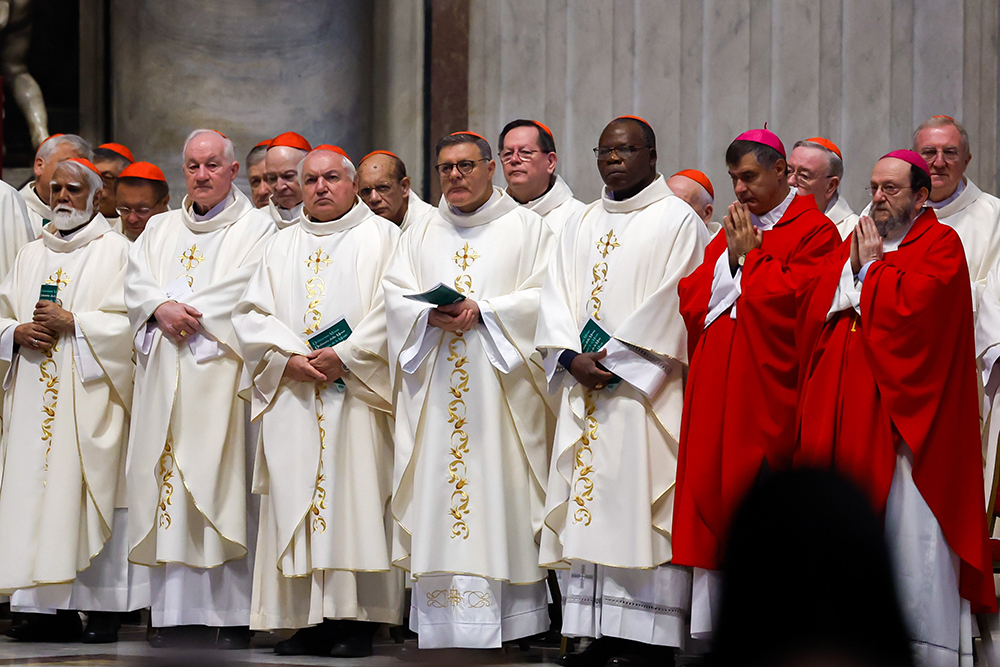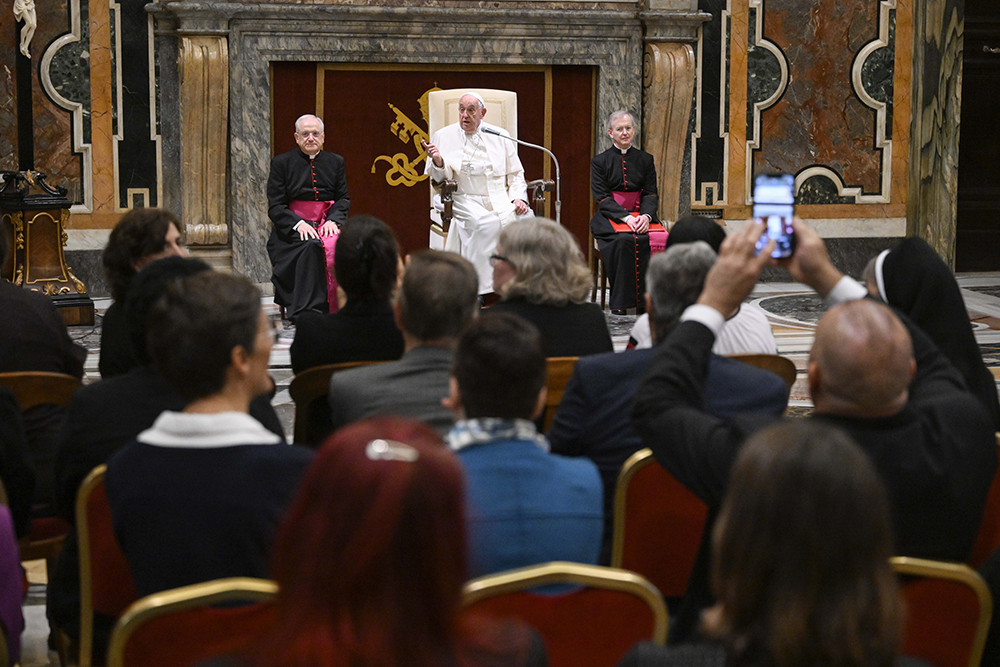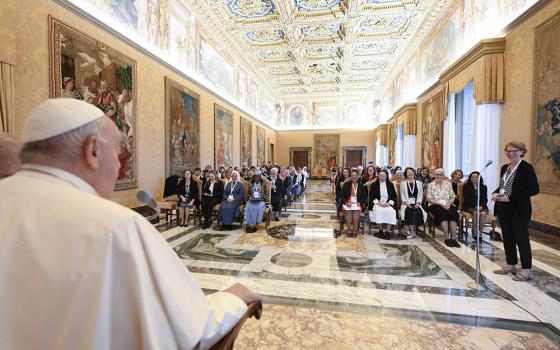
Cardinals pray during Mass presided by Cardinal Mario Grech, secretary-general of the Synod, at the Altar of the Chair in St. Peter’s Basilica at the Vatican Oct. 21, 2024. (CNS/Lola Gomez)
Although Pope Francis took it off the agenda, the appointment of bishops is still being discussed privately by members of the synod. The pope took this and a number of issues off the agenda because he wanted the synod to focus on synodality and not be distracted by controversial and complicated issues.
The synod on synodality is meeting in Rome during October, with bishops and lay people discussing how to make the church more transparent and accountable and less clerical. They are looking for ways to encourage respectful listening in the church so Catholics can discern together where the Spirit is leading the church.
The delegates, however, understand that synodality will not happen unless it is supported by bishops in their dioceses. Too many bishops see synodality as a threat to their authority or simply a waste of their time. The transparency, listening and accountability required of synodality are time-consuming and don't allow bishops to do whatever they want.
The selection of bishops has been a debated issue since apostolic times. There is no perfect way to select bishops. Every procedure has its plusses and minuses.
In earliest times, the process was very democratic. When a bishop died, the faithful would gather in the cathedral, look around and ask, "Who will be our leader?"
In ideal circumstances, the people reached consensus in their choice of leader. But if there was no consensus, factions formed to support different candidates. That is an inevitable result of democracy.
Advertisement
Too often, in the early days of the church, divisions in the community led to disagreements that became violent. In 217, pagan soldiers had to break up public brawls among the Christians in Rome fighting over who would be their bishop. The soldiers arrested both candidates (Callixtus and Hippolytus) and sent them to the tin mines of Sardinia.
Eventually, to avoid the laity fighting over who would be bishop, the electorate was limited to the clergy or part of the clergy, for example, the cathedral chapter.
Pope Leo I (440-461) said that to have a legitimate bishop, he had to be elected by the clergy, accepted by the people and consecrated by the bishops of the region.
The clergy would meet in the cathedral and elect someone. They would bring him out to the people and if they cheered, the clergy could present him to the regional bishops. If the people booed, the clergy would have to try again. If the bishops of the region refused to ordain him a bishop, the clergy would need to find a new candidate.
This was a checks-and-balances system that would have been loved by the writers of the Federalist Papers.
As the church got richer, interference in the selection of bishops by kings and nobles became common. They would use the threat of violence to force clergy to elect their candidate, who could be a relative or political supporter. The papacy also gave kings the right to appoint bishops in exchange for political or financial support. In a few instances, the kings used their power to reform the church, but the usual result was a very corrupt episcopacy, which prepared the church for the Reformation.
The great reform of the 19th century was to take the appointment of bishops away from political leaders and give it to the pope, who would be more concerned about the welfare of the church than government officials. This was possible because Napoleon had destroyed most of the Catholic monarchies.

Pope Francis speaks with lay women and men participating in or assisting the Synod of Bishops in the Apostolic Palace at the Vatican Oct. 19, 2024. (CNS/Vatican Media)
Leaving the selection of bishops to the total discretion of the pope led to its own problems when the Vatican placed its interests over the needs of the local church.
After the Second Vatican Council, Pope Paul VI looked for pastoral candidates in the United States, especially ones who got along with their clergy. They contrasted with earlier bishops who were more like bankers and builders.
John Paul II, on the other hand, was shocked by the rejection of Humanae Vitae, the 1968 encyclical forbidding artificial contraception, by many theologians and even some bishops. As a result, he looked for candidates who as bishops would enforce his positions on church issues. Benedict XVI continued John Paul's policies. Loyalty took precedence over pastoral qualities.
Francis is once again looking for pastoral bishops, especially ones who are close to the poor. He is more comfortable with discussion and debate in the church.
The current selection process is highly dependent on the nuncio, the pope's representative to the local church and government of a country. He presents three candidates for an open diocese to the Dicastery for Bishops along with a report on the diocese and a dossier on each candidate. He ranks them first, second and third choice.
The nuncio can consult with whomever he wants about the candidates, including bishops, clergy and lay people. He uses a confidential questionnaire to gather information on the candidates.
The Dicastery for Bishops makes a recommendation, which the prefect, or head of the dicastery, takes to the pope. The pope can choose one of the three candidates or tell the prefect to come back with a new list.
No public discussion of candidates is allowed under this system, which makes it difficult to have much lay involvement in the selection process. The hierarchy fears that public disclosure of the names of the candidates would lead to lobbying efforts and divisive campaigns, but keeping the laity out of the process is an example of clericalism and contrary to synodality.
Leaving the selection of bishops to the total discretion of the pope led to its own problems when the Vatican placed its interests over the needs of the local church.
The people of the diocese can be publicly consulted on what type of person they want, but they are forbidden to mention names publicly. This consultation is rarely done today, although it was more common in the time of Paul VI. The description of the ideal bishop by the laity in most dioceses was often unrealistic. As one observer noted, "They wanted Jesus Christ with an MBA from Harvard."
Synodality demands there be more transparency and consultation with the laity about the appointment of bishops. The Catholic Church could also learn by studying how leaders are chosen in other denominations. If other churches can successfully choose leaders in a more public process, why can't the Catholic Church?
Although in many parts of the world (like China), lay and clergy involvement would be exploited for political ends, there are places where the church is free to experiment with new methods.
For example, the nuncio could ask the diocesan priests' council to submit three names to him as candidates for bishop. Or he could share the names of his three candidates with the priests' council and get their response. The same could be done with the diocesan pastoral council to involve laity in the process.
Involving more people in the selection process could be divisive. Those who think more democracy is needed in the church need to recognize democracy does not always work that well in the political realm, even in America. But including more people in the selection would result in bishops who are embraced by their clergy and people. There are risks in opening up the process, but they are worth taking.
Since no system is perfect, we need to find something with checks and balances like the system proposed by Pope Leo I that involved clergy, laity and the college of bishops under the leadership of the pope. Whether we have the spiritual maturity to pull it off remains to be seen.
Synodality has shown that if we respectfully listen to one another in a prayerful setting, we are more likely to see where the Spirit is leading the church. It can also help us see who should be the best synodal leaders as bishops.







